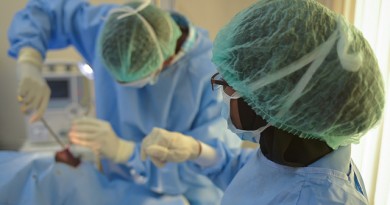How Much Does ACL Reconstruction Cost?
What Is ACL?
ACL stands for anterior cruciate ligament. The anterior cruciate ligament is one of four ligaments that connect the bones of the knee joint. The ACL is extremely important as it helps to keep the knee strong and stable. The anterior cruciate ligament can be torn by overstretching the knee. Tears to the ACL usually happen from a strong blow to the front of the knee or by the knee being suddenly stopped and twisted. ACL injuries are often sports related. ACL tears can be partial or complete. When an ACL injury occurs, sometimes a popping may be felt in the knee; shortly thereafter the knee may swell and become very painful. People with an anterior cruciate ligament injury may experience weakness in the knee and the knee may give out suddenly. In the majority of cases, an ACL injury will need to be surgically repaired. During ACL knee reconstruction, the torn ligament is removed and a tissue graft is inserted in its place.
The Cost
The cost of ACL reconstruction varies depending on the country the surgery is being done in, what insurance coverage the person has, what graft and procedure is used, and at what hospital it is being done in. Some insurance companies cover all of the ACL reconstruction cost, some give partial coverage and some do not cover it at all. ACL reconstruction cost includes pre-op appointments and consultations, pre-op and post-op physical therapy, the reconstruction surgery, anesthesia, prescriptions, rental fees for leg braces, crutches or a wheelchair, and other hospital fees. Most Americans with insurance will pay $2000-$3000 for ACL reconstruction; those without insurance will pay $6000-$10,000. In Canada, ACL reconstruction costs are covered by the Canadian Health Care System, so it is free; however, Canadians will have to pay for the use of crutches, leg brace or wheelchair, any post-op medications, and may have to pay for the physical therapy.
ACL Reconstruction Options
As a torn anterior cruciate ligament cannot be repaired, it needs to be removed and then replaced with a graft. There are several ACL reconstruction options for what type of graft is used. Patients can choose an allograft, patellar tendon graft or a hamstring tendon graft. The type of graft and if a single-bundle or a double bundle ACL reconstruction is used definitely affect ACL reconstruction cost.
The patellar tendon graft is taken from the patellar tendon of the patient. The advantages of this type of graft include that as it closely resembles the ACL it is easier for surgeons to work with and often heals stronger than the other graft types. However, there is an increased risk of patellar fracture or patellar tendon rupture after surgery, and many patients complain of knee pain in the front of the knee for years following the surgery.
For the hamstring tendon graft, two of the patient’s tendons are taken from the back of the patient’s thigh. The two tendons are bundled together and fitted in place to create a new anterior cruciate ligament. The advantage of a hamstring tendon graft is that it usually causes less pain immediately after the operation and in the following years than the patellar tendon graft. The disadvantages of a hamstring tendon graft are that it takes far longer for the graft to set and heal completely.
Allograft ACL reconstruction is a good choice for patients that do not participate in high impact activities or patients that have had a previous ACL reconstruction surgery that failed. An allograft is made from the tissue of a cadaver. An allograft is generally not as strong as a hamstring tendon graft or a patellar tendon graft; however, it is usually strong enough for patients that are not extremely active. The advantages of allograft ACL reconstruction are lessened surgery times and a smaller incision, a significant decrease in pain, and removal of other tissue from the patient is unnecessary. Disadvantages of allograft ACL reconstruction are that an allograft is weaker than the other graft types and that if the allograft is not sterilized properly there is a small risk of disease transmission and/or infection.
The majority of ACL reconstruction is done using a single-bundle reconstruction. However, a double bundle ACL reconstruction is also available. A double bundle ACL reconstruction is a fairly new procedure. With a single-bundle reconstruction one large graft is used; with a double bundle ACL reconstruction two smaller grafts are used. The advantage of a double bundle ACL reconstruction is that the knee seems stronger and more normal than when a single-bundle reconstruction is used. However, the procedure does require more surgery and as it is a relatively new procedure, the long-term effects are yet to be seen. Double bundle ACL reconstruction may prove to be a better way of doing ACL knee reconstruction than single-bundle reconstruction.
ACL Reconstruction Procedure
When torn, the anterior cruciate ligament cannot be repaired; ACL reconstruction is necessary. ACL knee reconstruction usually takes an hour and a half to two and half hours depending on the type of graft used and if there are any complications. Before the actual surgery, the doctor will usually insert an arthroscope into the knee so he can judge the damage to the joint. Once the doctor has a full understanding of the joint damage, he will harvest and prepare the graft. If the chosen graft is an allograft then the doctor will prepare it for use by thawing it. If the chosen graft is the patellar tendon graft or the hamstring tendon graft the doctor will make an incision in the patient and remove the needed tissue. Once the tissue is removed, the doctor will prepare it to become the new ACL. The doctor will then prepare the knee to attach the graft. The doctor will drill one tunnel in the end of the femur bone and another into the top of the tibia; the graft will then be attached to the bones with a pin or a screw. ACL reconstruction cost can be affected by the type of fixation device that is used and if there are any complications during the surgery.
ACL Reconstruction Recovery Timeline
ACL knee reconstruction usually takes six months to a year to fully recover from. It takes about six weeks for the graft to securely attach to the bone. Most patients use crutches for the first couple of weeks after surgery. By the end of the first six weeks after ACL reconstruction most patients have no further need of crutches or a knee brace, can walk up and down stairs, can drive, and can fully extend and bend the knee. From seven to twelve weeks most people are walking and going about their daily activities with no pain at all.
Around twelve weeks after ACL knee reconstruction patients can start jogging again. After the twelfth week, patients are able to be far more vigorous and active; most can safely jump, run and do exercise that is more strenuous. By the six month, most people are completely healed and able to go back to participating in all the activities they enjoyed before they tore their anterior cruciate ligament. However, some patients recover slower, and take nine months to a year to completely heal. Before patients get the green light from their doctor to return to unrestrained activity, they must pass a function profile test to ensure that the knee is completely healed. This test is also included in the overall ACL reconstruction cost and is absolutely necessary is it measures things like strength, mobility and balance of the reconstructed knee.
ACL Reconstruction Complications
As with any surgery, there is a risk of both major and minor complications from ACL knee reconstruction. All patients suffer from some degree of pain and swelling after surgery; however, the rare person will have permanent pain in the reconstructed knee. Some people experience a significant decrease in knee mobility or a loose knee after ACL reconstruction and are unable to resume their previous activity levels, and may need to have a second operation. Most people end up with a scar from the surgery and four people out of 10,000 will develop a serious infection from the surgery. During the surgery, there is a risk of serious blood loss that may require a blood transfusion, allergic reaction or equipment failure. In addition, there is a small risk of nerve damage, graft failure, blood clots and a fractured kneecap from ACL knee reconstruction. If an allograft is used, there is also a small risk of disease transmission. Fortunately, complications during and after ACL reconstruction are rare; the operation has an 80-90% success rate.
ACL Reconstruction Rehabilitation
ACL reconstruction rehabilitation takes time, dedication and hard work. During the first days after ACL knee reconstruction, the patient is required to both elevate and ice the knee to help alleviate swelling. Physical therapy for ACL reconstruction usually starts within the first couple of weeks after surgery. ACL reconstruction rehabilitation helps the patients to strengthen the knee and regain proper mobility. Physical therapy for ACL reconstruction starts with helping the patient extend and bend the knee and walk. During, the later weeks of rehab, patients will do aerobics, pool workouts, ride a stationary bicycle and other activities to help return normal function in the knee. Most people require about twenty physical therapy sessions after ACL knee reconstruction. In the Unites States, the cost of ACL reconstruction physical therapy sessions is about $70 each; some insurance companies cover rehab, others give partial coverage, and some give no coverage. Depending on the patient’s insurance coverage, physical therapy can add several hundred dollars or over a thousand to the overall ACL reconstruction cost.
- 759SHARES






